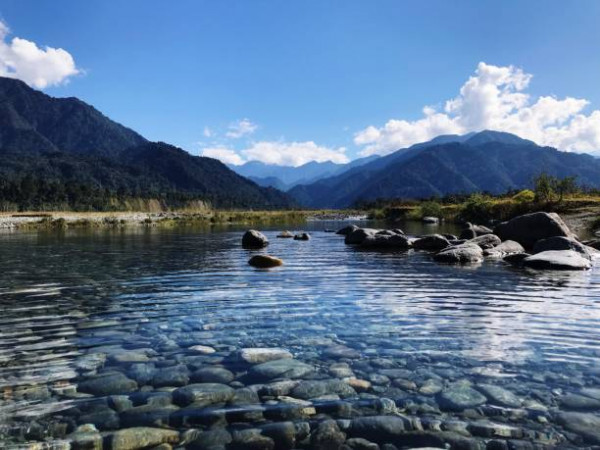
Pasighat
Package
6000 to 11000
6000 to 11000
Duration
2 to 4 Days
2 to 4 Days
Best time to visit
Oct-Jan
Oct-Jan
Theme
Hill Station, Adventure, Waterfront
Hill Station, Adventure, Waterfront
Pasighat Travel Guide
Pasighat, located in the northeastern state of Arunachal Pradesh in India, is a picturesque town nestled amidst the lush greenery of the Eastern Himalayas. Known for its rich cultural heritage and stunning natural beauty, Pasighat is a popular destination for nature lovers and adventure enthusiasts. The town holds historical significance as it was the first headquarters of the East Siang district and is home to various indigenous tribes.Top Attractions in Pasighat
- Daying Ering Wildlife Sanctuary
- Siyom Hanging Bridge
- Kekar Monying
- Pangin
- Brahmaputra Riverfront
Pasighat is Famous for
Its breathtaking landscapes and unique tribal culture.Top Attractions in Pasighat
- Explore the diverse flora and fauna at Daying Ering Wildlife Sanctuary
- Walk across the Siyom Hanging Bridge for stunning views
- Visit Kekar Monying for a glimpse into the local tribal life
- Experience river rafting at Pangin
- Relax by the Brahmaputra Riverfront
What's Great about Travelling to Pasighat?
- Perfect for nature enthusiasts
- Great for adventure seekers
- Offers a unique cultural experience
What's Not So Great about Travelling to Pasighat?
- Remote location, not easily accessible
- Limited accommodation options
- Weather can be unpredictable
Travel Tips for Pasighat
- Obtain necessary permits for visiting certain areas
- Prepare for varying weather conditions
- Respect the local customs and traditions
Important Pasighat trip information
- Ideal Duration: 3-4 days
- Best Time to Visit: October to March
- Nearby Airports and Railway Stations: Dibrugarh Airport and Murkongselek Railway Station
Top 5 Places to visit in Pasighat
FAQ's on Pasighat
Q1: What is the best time to visit Pasighat?
The best time to visit Pasighat is during the winter months from November to February when the weather is pleasant and cool. This period is ideal for exploring the natural beauty of the region without the hindrance of heavy rainfall. Additionally, various cultural festivals and events take place during this time, offering a unique insight into the local traditions.
Q2: Do I need a visa to travel to Pasighat?
Foreign tourists visiting Pasighat require a Protected Area Permit (PAP) or a Restricted Area Permit (RAP) due to its proximity to the international border. Travelers should check the latest visa requirements and restrictions before planning their trip to Pasighat.
Q3: What are the must-visit attractions in Pasighat?
Pasighat is known for its stunning natural landscapes, including the Siang River, Daying Ering Wildlife Sanctuary, and Kekar Monying. Visitors should not miss the Pasighat Buddha Vihar, Pangin and Komsing, and the indigenous Adi tribe villages for a cultural experience.
Q4: Is Pasighat a safe place to travel?
Pasighat is generally safe for travelers; however, it is advisable to be cautious in remote areas and follow local advice. Avoid trekking alone in the wilderness and stay informed about any potential weather-related risks. Always keep your belongings secure and be respectful of the local culture.
Q5: What is the local currency in Pasighat and can I use credit cards?
The local currency in Pasighat is the Indian Rupee (INR). While credit cards are not widely accepted in smaller establishments, larger hotels and some shops in urban areas may take them. It's recommended to carry sufficient cash, and ATMs are available in the town for convenience.
Q6: What is the local cuisine like in Pasighat?
Pasighat offers a blend of traditional Adi cuisine with influences from neighboring regions. Some popular dishes include bamboo shoot curry, smoked pork, apong (local rice beer), and various types of fish preparations. Vegetarians can enjoy dishes made with locally grown organic vegetables.
Q7: What transportation options are available in Pasighat?
Transportation in Pasighat includes public buses, shared taxis, and auto-rickshaws for local travel. Private taxis and rental cars are also available for exploring the nearby attractions. It's recommended to plan your transportation in advance, especially for remote areas.
Q8: Are there any cultural norms or etiquette I should be aware of when visiting Pasighat?
When visiting Pasighat, it's important to respect the local customs and traditions of the Adi tribe. Dress modestly, especially when visiting religious sites or rural areas. Seek permission before taking photographs of locals, and avoid discussing sensitive topics such as politics or religion. Embrace the local culture with an open mind and show appreciation for their way of life.
Q9: I am a travel agent. How can I buy travel leads of Pasighat?
Register yourself as a travel agent at agents.tripclap.com and then you can buy travel leads to Pasighat once your account is approved. For more details contact our support team at +91-8069186564 or support@tripclap.com








